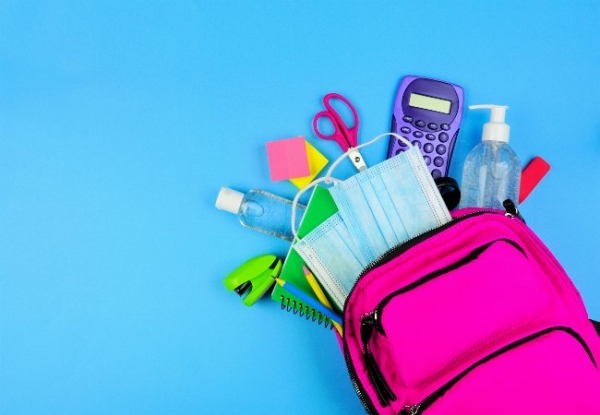Continued...

- Determine if you will be sending your child to school. Many of the schools that are reopening are still offering virtual options. You’ll want to first determine if you’ll be sending your child to school or not by assessing your family’s health risks and current living situation. Are you living in a multi-generational household with elderly parents who are compromised, for instance? While some early studies do show that children are less likely to spread the virus, children ages 10 and older are just as prone to spreading and contracting the virus as adults, other studies show. Furthermore, every child’s situation is unique. It may be worth it to consult your child’s pediatrician to decide if you should send your child to school in the fall, especially if your child has health conditions that predisposes them.
- Prepare COVID back-to-school supplies. Along with number two pencils, binders and backpacks, you’ll want to equip your child with the necessary supplies to protect from the virus. You’ll want to check with your school guidelines to see which hand sanitizers are allowed, if they are even allowed at all (some hand sanitizers have been reported to contain harmful chemicals). And it may be a good idea to order a few and see which one your child finds most comfortable. The most effective masks will be the one your child fidgets with least and keeps on the longest. Masks are not only are crucial in preventing the spread of the virus, but they have also been shown to protect the person wearing it.
- Prep your child about social distancing. It’s hard for kids to not touch their friends or get close. But keeping at least six feet apart from one another is going to be essential in keeping our schools open. Remind them that while this isn’t ideal, it’s better than not being able to see their friends at all, which is the situation for many other students in this country. So prep your child about good social distancing a measures. A good guide when it comes to social distancing is to behave as if you have the virus.
- Create a disinfectant ritual. Creating a disinfectant ritual after your child gets home can add one more layer of prevention from contracting the virus. My husband works as a first responder and we are careful to disinfect him the minute he gets home. I greet him, for instance, not with a hug or a kiss, but a bottle of hand sanitizer, which I squeeze a healthy dollop of into his hands. Next, he takes a Clorox wipe and wipes down his phone, wallet, watch and anything else he’s touched throughout the day. Then he sheds his scrubs in the garage and goes straight to the shower – and this before working out. He showers again after he works out. Just like it’s a good social distance practice to act as if you have the virus, a good disinfectant ritual might be to act as if the virus is on you. Just because the virus lives on surfaces, doesn’t mean you will contract it.
- Make sure your child gets plenty of sleep and eats a balanced meal. A good working immune system is the best fight against any illness.
- Monitor them daily. Check your child’s temperature every day. If he has a fever or is showing flu-like symptoms, don’t send your child to school.
IF YOU PLAN ON HOMESCHOOLING
Distance learning is challenging but there are more effective ways to handle it than being in a constant state of anxiety.
- Cut yourself some slack. Managing stressful situations begins with setting realistic expectations. Kelly Kang, a UCLA psychiatrist noticed a spike in concern during the pandemic from patients who suddenly think they have ADD. “The general sense is that a lot of people are working from home and they’re having to work in situations they’re not used to, and they’ve had to adjust, whether it’s creating office space in their home or working in the presence of children even if they’re in a separate room. And I think this is really hard, especially for people who are used to being very efficient and productive and on the go,” explains Kang. “I think we should all accept that productivity for most people is going to decrease. And that’s OK.”
- Get to know your neighbors. The easiest people to social distance with are your neighbors, who have direct access to their own homes and their own bathrooms. Whether it’s a simple favor like buying you groceries while they’re out, or keeping a distant eye on your child while attending to the stove, raising a child takes a village, especially during a pandemic.
- Create a schedule. Schedules can be beneficial because they help create routine. But make sure to create a schedule that works for you and your child. You’ll want set expectations about when it’s time for mom to help with school and when it’s not. Trying to work with constant interruptions is stressful and produces impatience. But setting up a schedule that attends to your child’s needs, and one that attends to your own will help reduce anxiety.
Related: Stay Sane and Create Much-Needed Boundaries with Your Child
- Hire a tutor. Many working parents have found the juggle of homeschooling and working not only challenging but paralyzing. If you’re in a position to outsource help, consider hiring a tutor who can help facilitate online learning and even supplement with enrichment learning. One great resource in finding a tutor is contacting your local colleges or universities. Ask if you can post a tutoring job. The pandemic has caused many layoffs and hiring freezes, even in the teaching industry. And for many college grads who would otherwise be getting jobs, they are now looking for something to hold them over until schools begin hiring again.
- Create a pod. To offset the cost of hiring a tutor, and to add a welcomed social element to virtual learning, parents have begun to form pods – a small group of families who share the teaching load and let their children interact with others. Emily Oster, a Brown University economist who writes about parenting, has predicted that clusters of home-schooling families are “going to happen everywhere.” The pursuit to form pods has already been trending on Next Door and Facebook. When creating a pod, consider the age of the children, locality, and those who share similar social distancing values. We are in this situation to preserve our safety after all.

Deborah Song